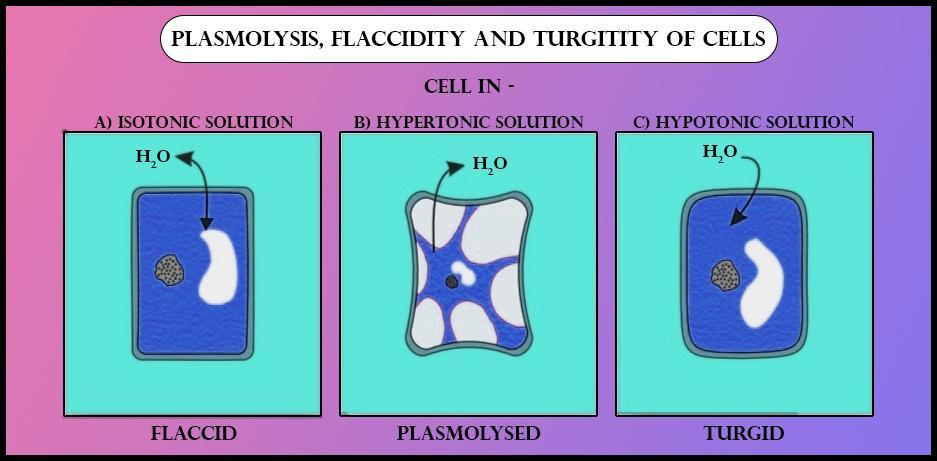
In a plasmolyzed cell, the space between the cell wall and plasma membrane is occupied by
(a) Hypotonic solution
(b) Hypertonic solution
(c) Isotonic solution
(d) Air
Answer
566.7k+ views
Hint: A cell is said to be plasmolyzed when all the water content in it moves out of it to the hypertonic solution in which the cell is present. The cell wall is known to be freely permeable i.e. it cannot regulate the movement of substances in and out of it.
Complete Step by Step Answer: Plasmolysis occurs when a cell is placed in a hypertonic i.e. very concentrated solution. Now the water potential of the cell is more than the water potential of the hypertonic solution. We know that water moves from higher water potential to lower water potential, thus, in this case, water will move from the cell to the solution. Because the concentration of the solution is so high, water will keep flowing out from the cell until there is minimal or no water left in it. This will result in the shrinking of the protoplasm so much that it shrinks away from the cell wall. Such a condition is known as a plasmolyzed cell.

Now, as the cell wall is freely permeable, it will allow everything inside it and hence in the space between the cell wall and plasma membrane, there will be a hypertonic solution present.
So, the correct option is ‘Hypertonic solution’.
Note:
- Plasma membrane is selectively permeable and thus is able to control the movement of substances in and out of it.
- If a cell is placed in an isotonic solution (solution with the same concentration as the cell) then the amount of water flowing inside the cell will be equal to the amount flowing outside. Such a condition is known as a flaccid cell.
- When a cell is placed in a hypotonic solution (dilute solution) , the cell swells up due to excess water moving into it. Such a cell exhibits turgor pressure.
Complete Step by Step Answer: Plasmolysis occurs when a cell is placed in a hypertonic i.e. very concentrated solution. Now the water potential of the cell is more than the water potential of the hypertonic solution. We know that water moves from higher water potential to lower water potential, thus, in this case, water will move from the cell to the solution. Because the concentration of the solution is so high, water will keep flowing out from the cell until there is minimal or no water left in it. This will result in the shrinking of the protoplasm so much that it shrinks away from the cell wall. Such a condition is known as a plasmolyzed cell.

Now, as the cell wall is freely permeable, it will allow everything inside it and hence in the space between the cell wall and plasma membrane, there will be a hypertonic solution present.
So, the correct option is ‘Hypertonic solution’.
Note:
- Plasma membrane is selectively permeable and thus is able to control the movement of substances in and out of it.
- If a cell is placed in an isotonic solution (solution with the same concentration as the cell) then the amount of water flowing inside the cell will be equal to the amount flowing outside. Such a condition is known as a flaccid cell.
- When a cell is placed in a hypotonic solution (dilute solution) , the cell swells up due to excess water moving into it. Such a cell exhibits turgor pressure.
Recently Updated Pages
Why are manures considered better than fertilizers class 11 biology CBSE

Find the coordinates of the midpoint of the line segment class 11 maths CBSE

Distinguish between static friction limiting friction class 11 physics CBSE

The Chairman of the constituent Assembly was A Jawaharlal class 11 social science CBSE

The first National Commission on Labour NCL submitted class 11 social science CBSE

Number of all subshell of n + l 7 is A 4 B 5 C 6 D class 11 chemistry CBSE

Trending doubts
10 examples of friction in our daily life

One Metric ton is equal to kg A 10000 B 1000 C 100 class 11 physics CBSE

Difference Between Prokaryotic Cells and Eukaryotic Cells

1 Quintal is equal to a 110 kg b 10 kg c 100kg d 1000 class 11 physics CBSE

State the laws of reflection of light

Explain zero factorial class 11 maths CBSE




